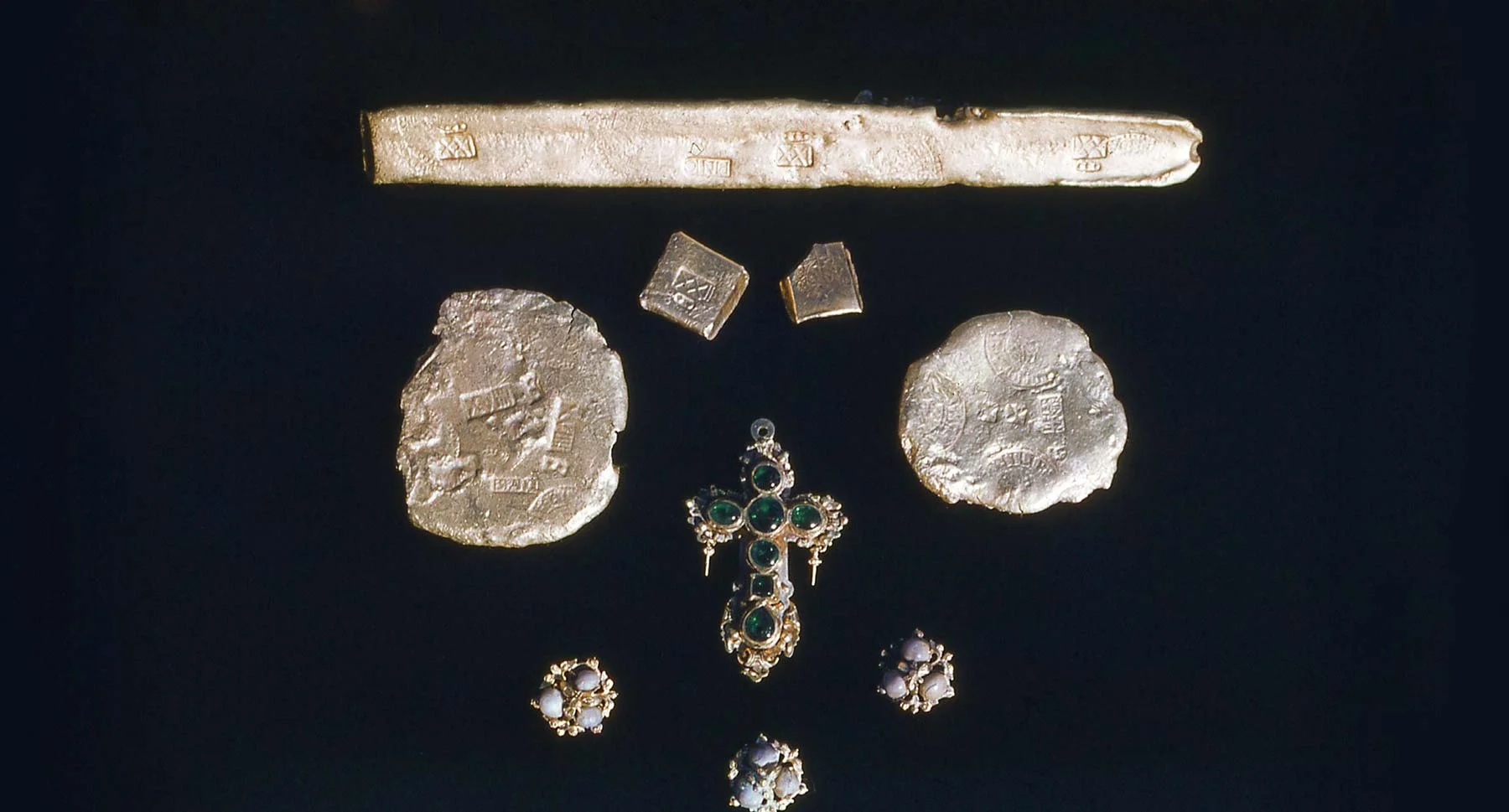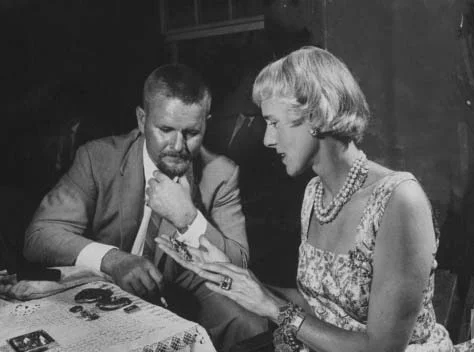Bermuda's Crown Jewels
The San Pedro was the first real treasure that was ever found on Bermuda’s reef. The haul included pearl buttons; disks, cubes, and bars of gold; hundreds of gold and silver coins; a gold chain and the emerald cross, not to mention hundreds of historic artifacts.
The cross and accompanying discoveries on the San Pedro received worldwide media coverage in January 1956 and was described as the most significant treasure haul found in the western hemisphere. Life Magazine and most illustrated publications in North America and Europe printed stories about the treasure.
In 1595 the cross was in transit from South America to Spain when the San Pedro lost its escort in a ferocious storm and was ripped apart on Bermuda’s deadly reefs. Spanish expeditions to the wreck site in the months that followed failed to recover the treasure. Along with the pearl buttons, the cross, most likely formed the ceremonial adornments for a bishop. But it was more than just incredible jewelry – it was a vessel for carrying sacred relics.
'The cross was by far the most important find we had made up to that date. It had seven emeralds that were set in such a fashion to symbolize and tell the story of the Crucifixion. The main gold structure of the cross consisted of four pieces, which could be dismantled like a Chinese puzzle. The back could be removed by twisting four gold studs which revealed a shallow recess, with two sets of opposing pointed keys to hold a sacred relic in place.'
The media were not the only ones interested in the cross.
Teddy declared the treasure to the Bermudian government and presented the finds to local dignitaries and government officials. Shortly afterwards the Bermudian government announced that the treasure belonged to them, stating that Bermuda’s territorial seabed was part of the British Crown Estate. Unfazed, Teddy told them that if that was the case then he would take it all back to the reef and they could look for it themselves. Knowing Teddy as a man of his word they agreed to negotiate.
Another interested party was US Ambassador to Italy, Clare Boothe Luce. A leading conservative she had converted to Roman Catholicism ten years earlier and on learning about the cross arranged to visit Teddy. They met at the house of Teddy's friend, photographer, Freddie Hamilton where she offered Teddy $100,000 for the cross. He said he could not accept but she persisted, finally offering $200,000 which Teddy again declined. 'At which point the discussion became quite heated. She was a wealthy socialite, a powerful politician. I'm sure she was not used to people saying no to her especially some young diver from this little island.' Wendy Tucker. A year later Clare Boothe Luce sent a representative to Bermuda instructing Teddy to name his price. Once again he declined.
The Bermudian government had by this time agreed that the treasure did belong to Teddy but if he wanted to sell it he had to offer it to them first. 'His overriding desire was for the treasure to stay together in Bermuda. He described it as Bermuda's Crown Jewels. That's why he sold it for such a reasonable price.' Wendy Tucker. The treasure haul including the cross was finally sold to the Bermudian government for £35,000 a fraction of its true value ( the cross alone was estimated to be worth $250,000 at the time). The 'Tucker Treasure' was put on public display at the aquarium.
Teddy was in his early thirties when he found the treasure and it was a pivotal moment in his life. It secured for him the funds and credibility to dedicate his time to searching for more wrecks. At a time when the exploration of space and the ocean was romanticized in popular culture like never before, Teddy's discovery thrust him into the limelight. Celebrities, journalists and fellow explorers sought him out when they visited the island. If you wanted to go diving in Bermuda, who better than with Teddy Tucker?
In 1975 Queen Elizabeth II visited Bermuda. The haul from the San Pedro, accompanied by treasures found on another wreck, the San Antonio were put on display for her at the Maritime Museum, with Teddy invited to host the viewing.
As the Queen was about to enter from the room next door, Teddy approached the table and cast his eye across the treasure. Wendy described watching the colour drain from her father's face. Reaching out he felt the veneer of gold paint on the fake cross was still tacky to the touch. The Tucker Cross had been swapped with a plastic replica. It was removed and the display was hastily rearranged. Composing a smile Teddy presented what remained of the treasure in a state of shock.
Several people had handled the treasure during its move from the Aquarium to the Bermuda Maritime Museum - at least three people had handled the fake cross as it was laid out for display yet no one noticed or perhaps dared to raise the alarm. A police investigation revealed that the key to the safe that housed the cross in the Aquarium was kept in an unlocked cabinet. The fact that the fake had not fully dried when Teddy discovered it, suggested the switch had taken place at some point over the preceding couple of days while the safe was in transit between the Aquarium and Museum. Few people were questioned and the investigation soon wound up.
And over the years, the cross was not the only piece of Teddy's treasure to go missing while in the care of one of Bermuda's museums. In 2005 visitors to the Bermuda Maritime Museum (now the Bermuda National Museum) alerted staff to missing exhibits from their display cases in the Treasury Room. The items stolen were a Gold ingot from the San Pedro and a gold nugget and gold chain from the San Antonio.
Like these other missing treasures, The Tucker Cross has never been found.
'It inspired me to work harder, and stay longer and look more. But I never found anything like it since.' Teddy Tucker








